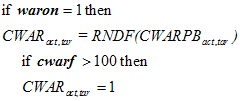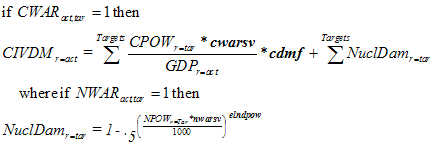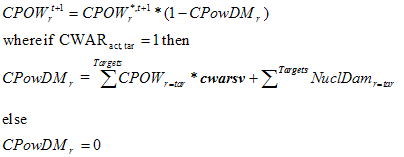International Futures Help System
IP Equations: War
IFs conceptualizes the threat variable (THREAT) as a probability of conflict, and initial conditions and parameters for its calculation were estimated primarily from militarized interstate dispute data. Across all dyads only a small portion (wpthrwar) of militarized disputes result in actual war. Knowing that percentage, it is possible to translate THREAT into the actual probability of war (CWARB), a variable that ranges from 0 to 100 (100% being certainty), just as THREAT ranges from 0 to 100. To allow the user more complete control over the probability of war in any given dyad, a second parameter (cwarbase), with a default value of 0, can be set from 0 to 100. Obviously, many variables, including factors such as relative power, affect whether or not countries in a dyad go to war. Remember that the THREAT variable is calculated so as to be responsive to such factors.
![]()
Even after the calculation of a war probability, however, IFs does not automatically proceed to generate a war and compute its consequences. The main reason is that, in the process of translating a probability into an event using a random number generator, a randomness is introduced into any model doing so. The philosophy of IFs use is that, unless the user consciously adds a random element, any run with a given set of parameters should always generate the same results and thus be easily compared with the base case.
Thus proceeding from probabilities of war to actual war events requires action on the part of the model user. Specifically, turning on a war parameter (waron) by moving it from the default value of 0 to the on value of 1 will do engage the linkage from war probabilities to war events.
There are two additional parameters that give users further control over war, once the waron parameter is set to 1. First, the conventional war base parameter (cwarbase), as noted above, can be adjusted. A value of 100, when waron is set to 1, will force a war in a given dyad. Second, a conventional war parameter (cwarf), also normally set to 0, can be set to 100 or more to force wars in all dyads, a true global war. The purpose of doing so is to allow assessment of damage potential from war, not because it is expected that a truly all-world war would ever occur.
As indicated, a random number generation function (RNDF) controls the process of moving from probability of war to actual conventional war (CWAR=1) or lack of it (CWAR=0). When waron is set to 1, a dyad in which the probability of war were an unusually high 10 percent would experience a war approximately every 10 years. Still, random behavior can generate a war each year or no war over 100 years.

The length of any conventional war (LENWAR) is purely random and varies from 1 to 6 years.
When nuclear powers are involved in conventional war, there is always a possibility of the escalation to nuclear war (NWARPB). The probability depends on the existence of the conventional war, an exogenously specified severity of war (cwarsv), and an exogenously specified probability for escalation (nwarf). Again, a random number generator translates that probability into the existence (NWAR=1) or nonexistence (NWAR=0) of nuclear war.

When war occurs, there are at least two kinds of consequences. The first is a spread to allies of the members of a dyad. The second is damage to populations and economies.
With respect to the spread of war, IFs makes the simplifying assumption that all allies of each partner as specified exogenously in the alliance parameter (ally) become involved in the conflict. This is not always true, but the model user can easily control it through the alliance parameter.
With respect to the calculation of damage, IFs computes civilian damage multipliers (CIVDM) for all participants. The basic assumption is that damage to an active participant, the actor, is directly proportional through a severity factor (cwarsv) to the conventional power (CPOW) of the opposing participant, the target), and inversely proportional to the GDP of the actor. A further parameter, the civilian damage multiplier factor (cdmf) allows more complete control over the damage assessment. If there is a nuclear war involved as well as a conventional one, nuclear damage (NuclDam) from all "war partners" (targets) is added to the conventional damage.
The resultant civilian damage multiplier is used in population and economic models to reduce population and economic capital, as described in the documentation of those models.

War also weakens conventional power, through use and through destruction. The conventional damage multiplier (CPowDM) is fundamentally analogous to the civilian damage multiplier, except that it does not involve the inverse relationship to GDP size. The multiplier revises the earlier calculation of conventional power as it is carried forward to the next time period.

IFs assumes the reduction of nuclear power only in the case of nuclear war (an assumption, as Iraq can testify, that is not always valid). The reduction in each country's or region's nuclear power is proportional to their initial power level (in nuclear wars, almost all nuclear power would presumably be used).

 International Futures at the Pardee Center
International Futures at the Pardee Center